November 11, 2020
During the nuclear war threat of the 1950s and 60s, people talked about fallout and built shelters to survive it. Today in Hawaii, we’re still talking about fallout, and still making shelters. This time, though, it’s for the birds.
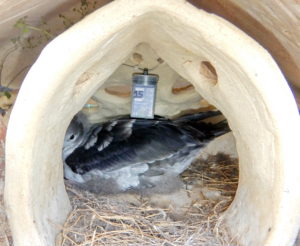
Workers from the nature nonprofit, Oikonos, built and placed this “nest”, and other such clay shearwater homes, at the Freeman Seabird Preserve on Oahu. The hanging thermometer records temperatures inside the artificial burrow. This chick (photo yesterday) is close to fledging. ©Susan Scott
During November and December each year, shearwater chicks leave their burrow nests for the open ocean, guided by starlight and moonlight reflecting on the water’s surface. Electric lights, however, trick the young seabirds into flying inland where they get lost, and either fall down exhausted, or hit human structures and lay stunned on the ground. This native bird calamity is also called fallout.
Sometimes, seabird fallout is fatal, but often the birds can be saved by kind people who find them and take them to an approved shelter. See how to do it at this short, charming site: https://www.youtube.com/watch?v=5L4E8FaCo_Y
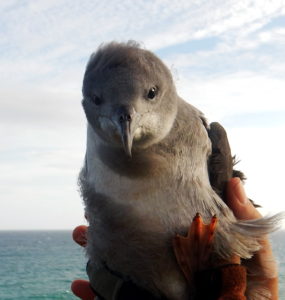
This downy wedge-tailed shearwater chick, picked up this week for measuring and banding by seabird researcher, Dr. David Hyrenbach, will soon be ready to launch. Freeman Seabird Preserve. ©Susan Scott
Fallout time starts now, and continues into mid-December. If you find a bird on the ground, and aren’t sure what it is, send a photo to birdhelp@hawaiiwildlifecenter.org and they will identify it. You can also contact me at this site.
On Oahu, our common fallout victims are wedge-tailed shearwaters, affectionately known as wedgies, that nest at Kaena Point, on our windward islands, and in several other areas.
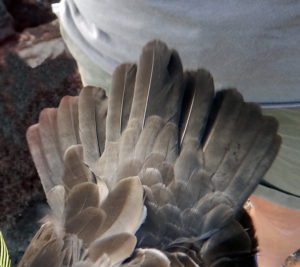
Wedge-tailed shearwaters are well-named. This photo shows a chick fanning its tail during the placement of a tiny ID bracelet, or band, on its right leg. This so-called “banding” is the only way scientists can learn where the birds go and how long they live. ©Susan Scott
If you find a wedgie on Oahu, please take it to an approved drop-off site:
- Feather and Fur Animal Hospital, 24/7.
- Hawaii Human Society, 24/7 i
- Sea Life Park, 24/7
- James Campbell National Wildlife Refuge, 8-5, M-F
For more details, and for neighbor island drop-offs, see http://dlnr.hawaii.gov/wildlife/downed-wildlife-contact-details/
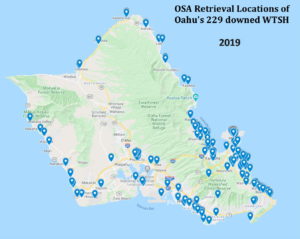
This shows where downed wedge-tailed shearwaters (WTSH) were picked up last year. Map by Oahu Seabird Aid, a program of the Hawaii Wildlife Center, Kapaau, Hawaii Island.
At drop-off sites, a manager from the Hawaii Wildlife Center will determine if a bird can be released after short-term care, or if it needs to go to the wildlife hospital and rehab center at Kapaau on the Big Island, www.hawaiiwildlifecenter.org
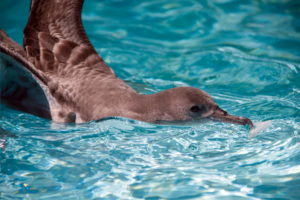
A rescued wedge-tailed shearwater takes a dip in the conditioning pool at the Hawaii Wildlife Center. Photo courtesy HWC.
Widespread efforts to rescue Hawaii’s shearwaters are the result of cooperation by state, federal, and nonprofit wildlife organizations, a hui that grows each year as more people become aware of the seabirds’ plights. Knowing about these native birds, and what to do if you find one, is key to saving the species. Please share this information.
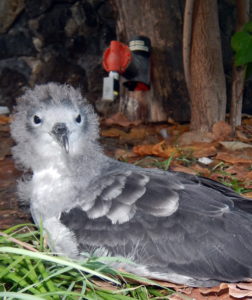
This wedge-tailed shearwater chick, photographed yesterday, grew up in the Hawaii Audubon Society’s Freeman Seabird Preserve, Black Point, Oahu. The youngster will fly away soon. The device behind the bird is a rat trap. ©Susan Scott
Learn more about wedgies at https://www.freemanseabirdpreserve.com/, a program of the Hawaii Audubon Society. Included are classroom lessons showing how wedgies, or ‘ua‘u kani, live and survive around Oahu. (For grades 6 – 8 with suggested modifications for grades 9 – 12.)
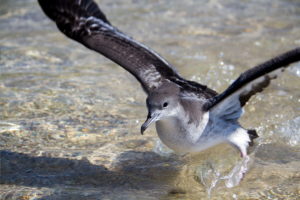
Courtesy Hawaii Wildlife Center
For Hawaii’s native seabirds, fallout has a whole new meaning from what it did during the Cold War, but for our wedgies, it’s just as deadly. We can help these magnificent birds by turning off outdoor lights during fledging season, keeping dogs and cats leashed, and going out of our way to rescue downed birds. These small efforts are well worth the good feeling that comes from rescuing a native species. The opposite of fallout is uplift.
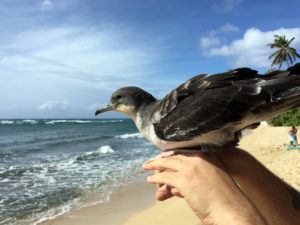
It may be possible to attend a bird release, an uplifting experience for both human and bird. Contact Rae Okawa at on the Hawaii Wildlife Center link above. Photo courtesy Hawaii Wildlife Center.